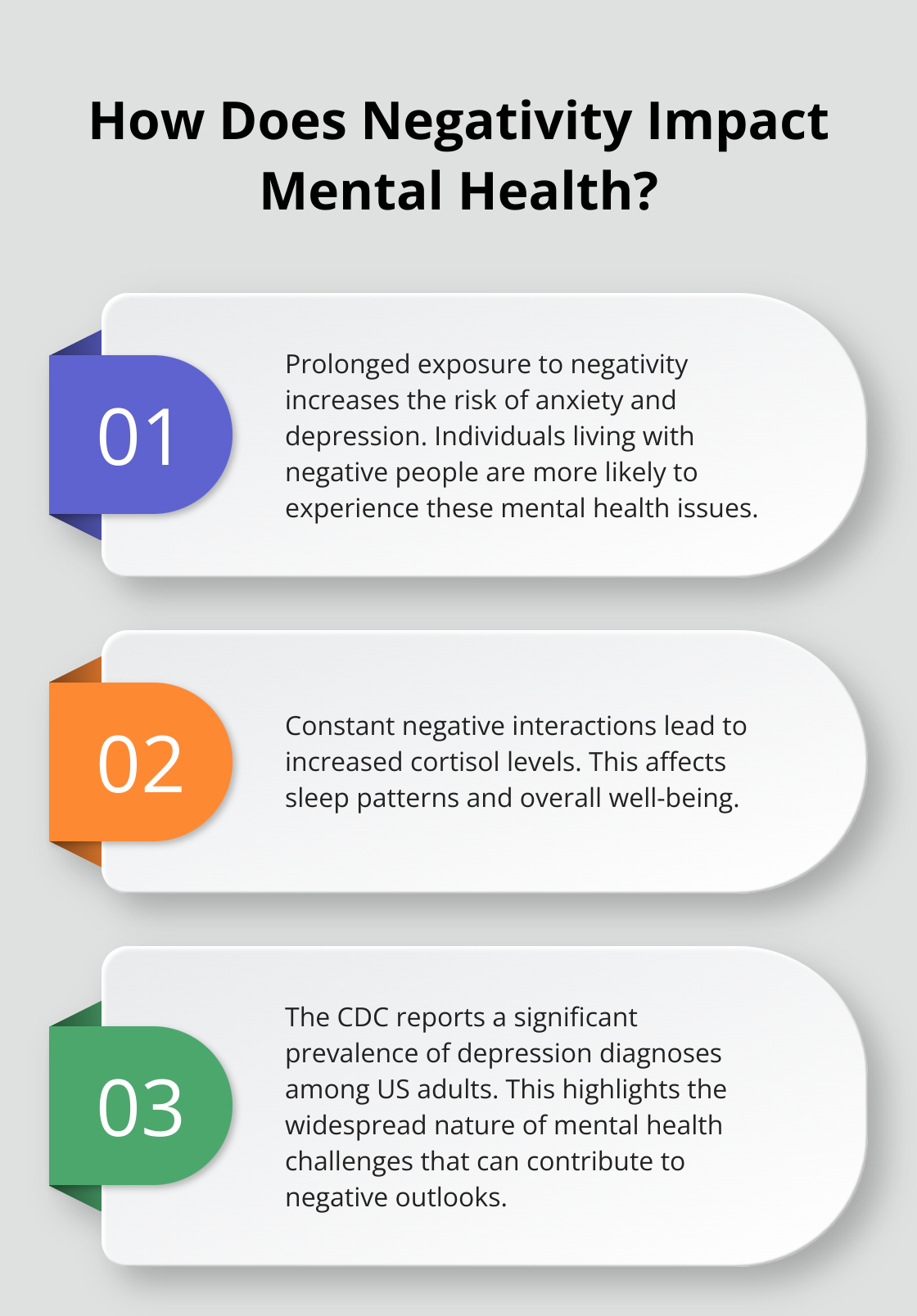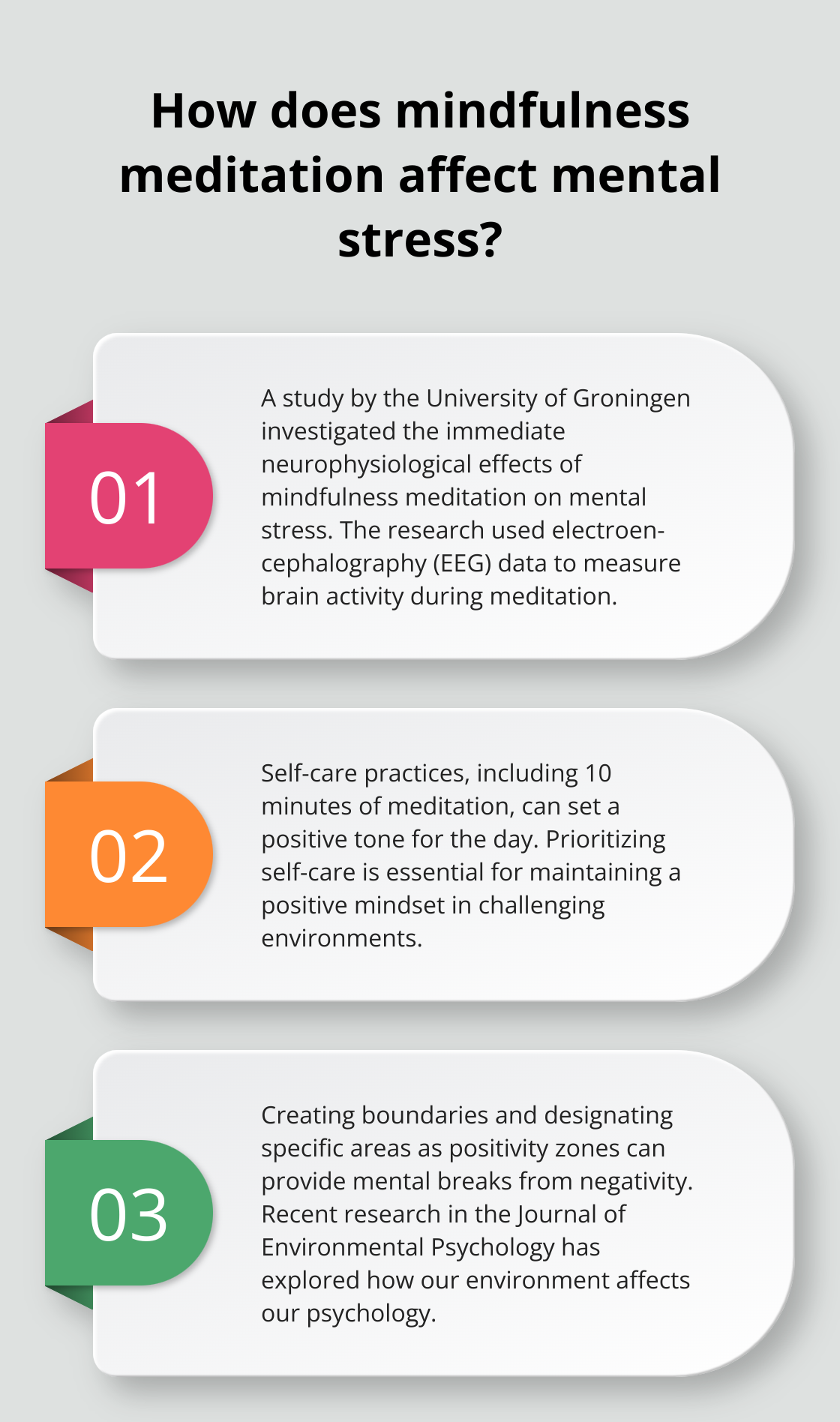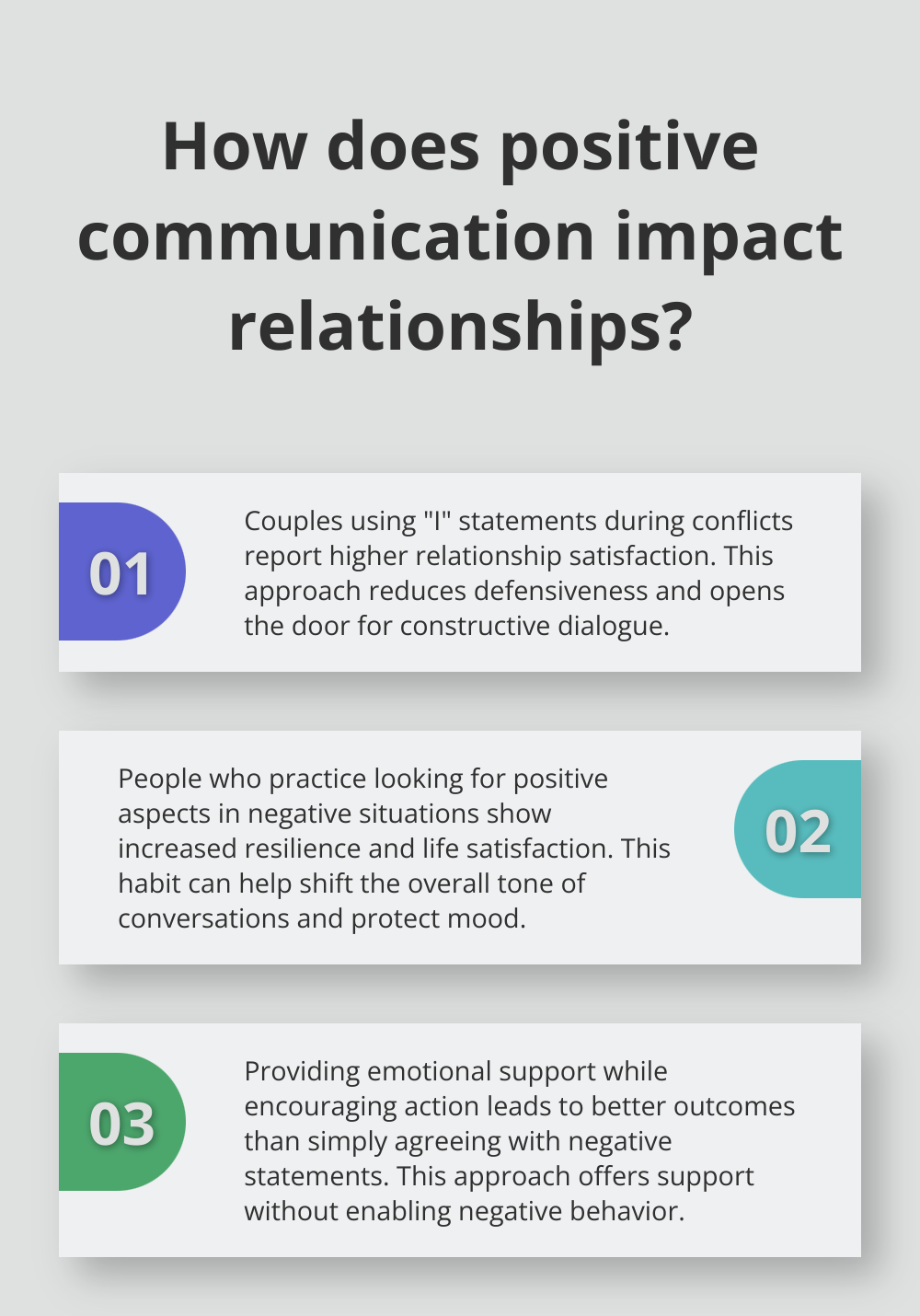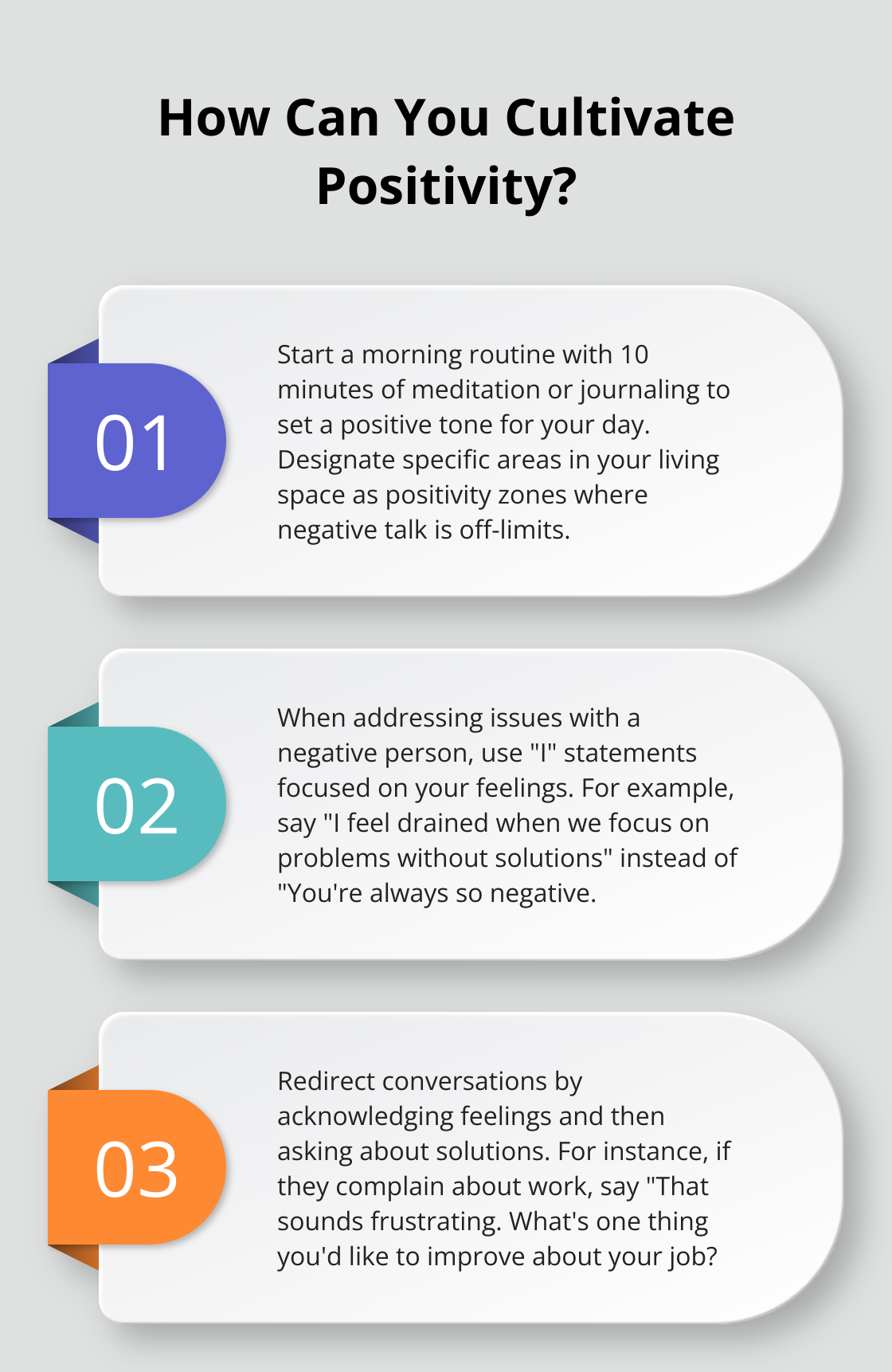Living with a negative person can be challenging, but it doesn’t have to drain your positivity. At Global Positive News Network, we understand the importance of maintaining a positive outlook, even in difficult circumstances.
This blog post will explore practical strategies on how to stay positive when living with a negative person. We’ll cover effective communication techniques, self-care practices, and ways to set healthy boundaries while preserving your mental well-being.
How Negativity Affects Us
The Ripple Effect of Negative Behavior
Negative behavior patterns manifest in various ways, such as constant complaining, pessimistic outlooks, or criticism of others. These behaviors create a ripple effect, influencing the emotional atmosphere of a household or workplace. A study published in the Journal of Applied Psychology reveals insights into workplace behavior and productivity.
Mental Health Consequences
Prolonged exposure to negativity can have serious consequences for mental health. Research from the University of Michigan indicates that individuals living with negative people are more likely to experience symptoms of anxiety and depression. The stress of constantly navigating negative interactions can lead to increased cortisol levels, affecting sleep patterns and overall well-being.
Root Causes of Negative Tendencies
Understanding why some people tend towards negativity can help in developing empathy and effective communication strategies. Often, negative behavior stems from underlying issues such as past traumas, learned behaviors, or undiagnosed mental health conditions. A study by the CDC provides insights into the prevalence of depression diagnoses among adults in the United States, highlighting the prevalence of mental health challenges that can contribute to negative outlooks.
Breaking the Cycle
Recognizing the impact of negativity is essential for breaking the cycle. You can start to implement targeted strategies to protect your mental health by identifying specific negative behaviors and their effects. This might involve setting clear boundaries, practicing self-care, or seeking support from positive influences in your life.
Moving Forward
While it’s important to understand the roots of negativity, it’s equally vital to prioritize your own well-being. The following sections will explore practical techniques for maintaining positivity and effectively communicating with negative individuals, ensuring you can thrive even in challenging environments. These strategies will equip you with the tools necessary to navigate difficult relationships while preserving your mental health and positive outlook.

How Can You Stay Positive?
Prioritize Self-Care
Self-care is not selfish; it’s essential. Start a morning routine that sets a positive tone for your day. This could include 10 minutes of meditation, journaling, or light exercise. A study by the University of Groningen aimed to investigate the immediate neurophysiological effects of mindfulness meditation on mental stress using electroencephalography (EEG) data.

Add activities that bring you joy to your daily schedule. Whether it’s reading, painting, or gardening, make time for hobbies that recharge your emotional batteries.
Create Boundaries
Set clear boundaries when living with a negative person. Communicate your limits calmly and assertively. For example, you might say, “I need some quiet time after work to decompress. Can we agree not to discuss any problems during this time?”
Designate specific areas in your living space as positivity zones where negative talk is off-limits. This physical separation can provide a mental break from negativity. Recent research in the Journal of Environmental Psychology has explored various aspects of how our environment affects our psychology.
Cultivate Positive Relationships
Surround yourself with positive influences. Seek out friendships and connections that uplift and inspire you. Join local clubs or online communities aligned with your interests.
Consider volunteering for a cause you care about. This exposes you to like-minded, positive individuals and boosts your own sense of purpose and well-being.
Practice Gratitude
Focus on gratitude to shift your perspective, even in challenging environments. Start a gratitude journal, writing down three things you’re thankful for each day.
Set Personal Growth Goals
Create personal growth goals that excite you. Whether it’s learning a new skill or working towards a career milestone, having something positive to focus on can counteract the negativity around you.
Staying positive is an active choice. You can’t control the negativity of others, but you have the power to shape your own mindset and environment. These strategies don’t just help you survive in a negative environment; they empower you to thrive despite it. Now, let’s explore how to effectively communicate with a negative person to further improve your situation.
How to Talk to a Negative Person
Express Yourself Clearly
When you address issues, use statements that focus on your feelings and experiences. Instead of saying “You’re always so negative,” try “I feel drained when we focus on problems without solutions.” This approach reduces the likelihood of triggering defensiveness and opens the door for constructive dialogue.

A study by the University of Georgia found that couples who used “I” statements during conflicts reported higher relationship satisfaction. You can apply this technique in your interactions with negative individuals to foster understanding and reduce tension.
Redirect Conversations Positively
Steer conversations towards more positive topics gently. When faced with a complaint, acknowledge the person’s feelings, then ask about potential solutions or silver linings. For instance, if they complain about work, you might say, “That sounds frustrating. What’s one thing you’d like to improve about your job?”
Research from the University of California, Berkeley suggests that people who practice looking for positive aspects in negative situations show increased resilience and life satisfaction. They go through life easily seeing the positive in irritations and bad events, which helps protect their mood. You can encourage this habit in your conversations to help shift the overall tone.
Offer Support Without Enabling
Show empathy and understanding, but avoid reinforcing negative behavior. Listen actively, then guide the conversation towards problem-solving or distraction. You might say, “I hear you’re having a tough time. What’s one small step we could take to improve the situation?”
A study published in the Journal of Personality and Social Psychology found that providing emotional support while encouraging action led to better outcomes than simply agreeing with negative statements.
Know When to Disengage
Recognize when a conversation becomes unproductive. It’s okay to set limits on negative interactions. You could say, “I understand you’re upset, but I don’t think this conversation helps either of us right now. Let’s take a break and revisit this later when we’re both calmer.”
The American Psychological Association emphasizes the importance of setting boundaries in relationships to maintain mental health. Experts suggest being aware of multiple relationships and responding in a way that is helpful but maintains appropriate boundaries. Don’t hesitate to step away from conversations that drain your positivity.
Changing communication patterns takes time and practice. Be patient with yourself and the other person as you implement these strategies. With consistent effort, you can create a more positive communication environment (even when living with a negative person).
Final Thoughts
Living with a negative person challenges your positivity, but you can maintain your mental well-being. You protect your emotional health when you set clear boundaries, practice self-care, and surround yourself with positive influences. Effective communication plays a key role in how to stay positive when living with a negative person.

You express your feelings clearly with “I” statements, redirect conversations towards positivity, and offer support without enabling negative behavior. You balance empathy with self-preservation and recognize when to step back from unproductive interactions. Professional help from a therapist or counselor provides additional strategies tailored to your specific situation.
We at Global Positive News Network believe in the power of positivity to transform lives. Our platform offers uplifting stories and resources to help you maintain an optimistic outlook (even in challenging circumstances). You create a positive mindset that withstands external negativity through patience, practice, and perseverance.




